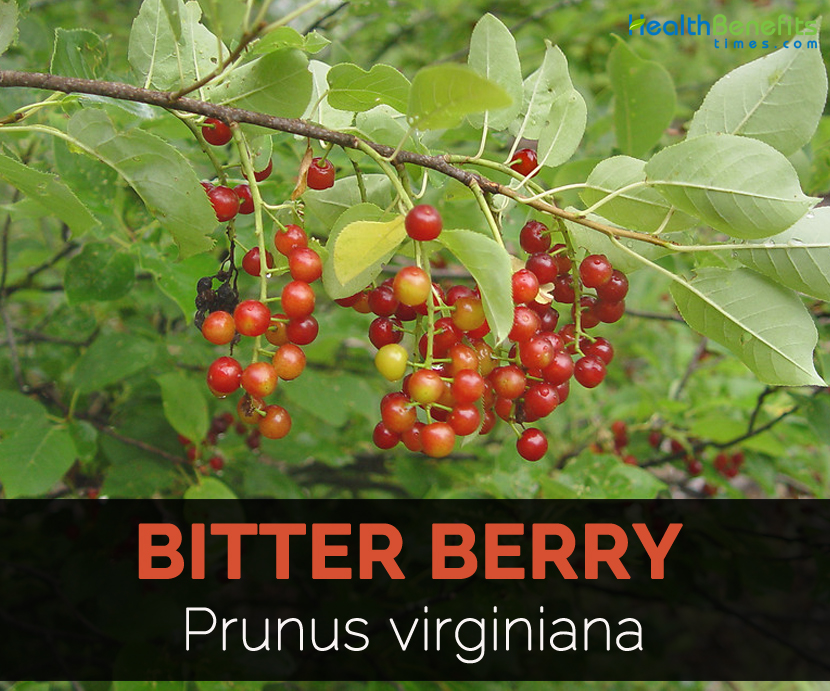| Bitter Berry Quick Facts | |
|---|---|
| Name: | Bitter Berry |
| Scientific Name: | Prunus virginiana |
| Origin | Native to North America and is found in Canada, Florida, Minnesota, Nebraska, Kansas, Louisiana, Texas. |
| Colors | Dark red fruit |
| Shapes | Spherical drupes, globose, 1/4 to 3/8 inch in diameter |
| Taste | Bitter and astringent |
| Calories | 249 Kcal./cup |
| Major nutrients | Total dietary Fiber (81.05%) Carbohydrate (39.83%) Copper (31.83%) Manganese (27.92%) Vitamin K (27.08%) |
| Name | Bitter Berry |
|---|---|
| Scientific Name | Prunus virginiana |
| Native | Native to North America and is found in Canada, Florida, Minnesota, Nebraska, Kansas, Louisiana, Texas. |
| Common/English Name | Wild Black Cherry Bark, Choke Cherry, Common chokecherry, Black chokecherry, Red chokecherry, Virginia chokecherry, California chokecherry, Eastern chokecherry, Western chokecherry, Rum chokecherry, Wild blackcherry, Whiskey chokecherry, Wild cherry, Bird cherry Chokeberry, Jamcherry, Cabinet cherry, Chuckleyplum, Bitter-berry, Sloe tree, Caupulin |
| Plant Growth Habit | Suckering hardy tree or large shrub |
| Plant Size | 1 to 6 m tall |
| Bark | Blackish and rugged |
| Branches | Smooth, red or purplish |
| Leaf | Elliptic to ovate, and 3 to 10 cm long |
| Medicinal part | The young thin bark |
| Flowering Season | Summer |
| Flower | Creamy-white |
| Fruit shape & size | Spherical drupes, globose, 1/4 to 3/8 inch in diameter |
| Fruit color | Dark red fruit |
| Flavor/aroma | Strong |
| Fruit Taste | Bitter and astringent |
Leaf
Leaves are alternate, simple, oblong to nearly oval and 2 to 4 inches long. It has finely serrated margin, dark green above and paler below, minute glands on petiole.
Flower
Flower is white, in a loose 3 to 6 inches long terminal raceme, appearing after leaves.
Fruit
Flowers are then dark red to purple drupe and 1/3 diameter and matures in late summer.
Twig
Twigs are slender, black cherry and light brown to gray.
Bark
Bark is smooth, gray-brown, conspicuous lenticels that develop into shallow fissures; young stems have shallowly peeling, curling layers.
- Bark and roots act as blood tonic, pectoral, astringent, tonic, sedative and appetite stimulant.
- Root bark infusion is used to treat coughs, fevers and colds.
- Use the root bark as a wash for old sores, burns and ulcers.
- Use the inner bark for treating wounds.
- Dried and powdered fruits are used for stimulating appetite, bloody discharges of bowels and treat diarrhea.
- Unriped fruit is used for treating diarrhea.
Culinary uses
- Fruits are used to make jams and jellies, syrups, pie filings and wines.
- Fruits can be sundried.
- Bark is used to brew tea.
- Fruits are used to flavor soups and stews or as a thickening agent.
- It is used for making cakes and pies.
Side Effects
- It can cause mild headache and ulcers.
- Excessive intake causes constipation and other abdominal problems.
- It also increases toxicity in stomach.
Dose
15 drops in water. Cherry bark will dissolve stones but should be combined with other herbs and administered carefully and over a period of several months, as when taken too fast will expel the stones abruptly without being softened.
Homoeopathic Clinical
Cold infusion or tincture of inner bark; solution of concentrated resinous extract, Prunin—Acidity, Anorexia, Dyspepsia, Heart (weakness of, hypertrophy of. irritable), Pyrosis.
References:
https://web.uri.edu/rhodeislandwoods/files/Prunus-virginiana.pdf
https://practicalplants.org/wiki/Prunus_virginiana
http://foodsportal.com/chokecherry/
https://www.onlyfoods.net/chokecherry.html
Comments
comments
